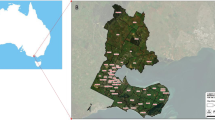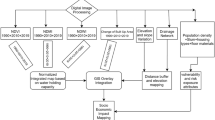Abstract
Risk management in urban planning is of increasing importance to mitigate the growing amount of damage and the increasing number of casualties caused by natural disasters. Risk assessment to support management requires knowledge about present and future hazards, elements at risk and different types of vulnerability. This article deals with the assessment of social vulnerability (SV). In the past this has frequently been neglected due to lack of data and assessment difficulties. Existing approaches for SV assessment, primarily based on community-based methods or on census data, have limited efficiency and transferability. In this article a new method based on contextual analysis of image and GIS data is presented. An approach based on proxy variables that were derived from high-resolution optical and laser scanning data was applied, in combination with elevation information and existing hazard data. Object-oriented image analysis was applied for the definition and estimation of those variables, focusing on SV indicators with physical characteristics. A reference Social Vulnerability Index (SVI) was created from census data available for the study area on a neighbourhood level and tested for parts of Tegucigalpa, Honduras. For the evaluation of the proxy-variables, a stepwise regression model to select the best explanatory variables for changes in the SVI was applied. Eight out of 47 variables explained almost 60% of the variance, whereby the slope position and the proportion of built-up area in a neighbourhood were found to be the most valuable proxies. This work shows that contextual segmentation-based analysis of geospatial data can substantially aid in SV assessment and, when combined with field-based information, leads to optimization in terms of assessment frequency and cost.





Similar content being viewed by others
Abbreviations
- DSM:
-
Digital surface model
- nDSM:
-
Normalized digital surface model
- DTM:
-
Digital terrain model
- GIS:
-
Geoinformation System
- OOA:
-
Object-oriented analysis
- PV:
-
Physical vulnerability
- SV:
-
Social vulnerability
- SVI:
-
Social Vulnerability Index
- TTA:
-
Test and training areas
References
Adger WN, Kelly PM (1999) Social vulnerability to climate change and the architecture of entitlements. Mitigation Adapt Strat Glob Change 4(3–4):253–266
Angel S, Bartley K, Derr M, Malur A, Mejia J, Nuka P, Perlin M, Sahai S, Torrens M, Vargas M (2004) Rapid urbanization in Tegucigalpa, Honduras. Preparing for the doubling of the city’s population in the next twenty-five years. Report from Woodrow Wilson School of Public and International Affairs, Princeton University, 74 pp
Allen KM (2006) Community-based disaster preparedness and climate adaptation: local capacity-building in the Philippines. Disasters 30:81–101. doi:10.1111/j.1467-9523.2006.00308.x
Arciniegas G, Bijker W, Kerle N, Tolpekin V (2007) Coherence- and amplitude-based analysis of seismogenic damage in Bam, Iran, using Envisat ASAR data. IEEE Trans Geosci Remote Sens 45:1571–1581. doi:10.1109/TGRS.2006.883149
Baatz M, Benz U, Dehghani S, Heynen M, Höltje A, Hofmann P, Lingenfelder I, Mimler M, Sohlbach M, Weber M, Willhauck G (2004) eCognition user guide 4. Munich
Bacon C, Mastin L, Scott K, Nathenson M (1997) Volcano and earthquake hazards in the Crater Lake region, Oregon. U.S. Geological Survey Open-File Report 97-487
Balz T, Haala N (2003) SAR-based 3D-reconstruction of complex urban environments. Int Arch Photogramm Remote Sens 34:181–185
Birkmann J (2005) Measuring vulnerability. Report on the 1st meeting of the expert working group “Measuring Vulnerability” of the United Nations University Institute for Environment and Human Security (UNU-EHS), Bonn
Blaschke T, Strobl J (2001) What’s wrong with pixels? Some recent developments interfacing remote sensing and GIS. GIS 6:12–17
Briguglio L (2003) The vulnerability index and small island developing states: a review of conceptual and methodological issues. Department of Economics, University of Malta, Msida
Cardona OD (2003) Indicators for disaster risk management. First expert meeting on disaster risk conceptualization and indicator modelling. Manizales, March 2003
Clark GE, Moser S, Ratick S, Dow K, Meyer WB, Emani S, Jin W, Kasperson JX, Kasperson RE, Schwarz HE (1998) Assessing the vulnerability of coastal communities to extreme storms: the case of Revere, MA, USA. Mitigation Adapt Strat Glob Change 3(1):59–82
CINDI (1998) Central America: Hurricane Mitch OFDA-12: 12-Nov-98. USAID/OFDA Hurricane Mitch Fact Sheet 12
Coburn AW, Spence RJS, Pomonis A (1994) A vulnerability and risk assessment, 2nd edn. United Nations Development Programme (UNPD)
Cressie NAC (1991) Statistics for spatial data. Wiley, New York
Cutter SL, Boruff BJ, Shirley WL (2003) Social vulnerability to environmental hazards. Soc Sci Q 82:242–260. doi:10.1111/1540-6237.8402002
Dash J, Steinle E, Singh RP, Baehr HP (2004) Automatic building extraction from laser scanning data: an input tool for disaster management. Adv Space Res 33:317–322. doi:10.1016/S0273-1177(03)00482-4
Davidson C (2006) Was 2005 the year of natural disasters? Bull World Health Organ 84:4–8
Draper NR, Smith H (1981) Applied regression analysis. In: Bradley RA, Hunter JS, Kendall DG, Watson GS (eds) Wiley series in probability and mathematical statistics. Wiley, New York
Dwyer A, Zoppou C, Nielsen O, Day S, Roberts S (2004) Quantifying social vulnerability: a methodology for identifying those at risk to natural hazards. Geoscience Australia
Eakin H, Luers AL (2006) Assessing the vulnerability of social-environmental systems. Annu Rev Environ Resour 31:365–394. doi:10.1146/annurev.energy.30.050504.144352
Emdad Haque C, Etkin D (2007) People and community as constituent parts of hazards: the significance of societal dimensions in hazards analysis. Nat Hazards 41:271–282. doi:10.1007/s11069-006-9035-8
Espindola G, Camara G, Reis I, Bins L, Monteiro A (2006) Parameter selection for region-growing image segmentation algorithms using spatial autocorrelation. Int J Remote Sens 27:3035–3040. doi:10.1080/01431160600617194
Flint CG, Luloff AE (2005) Natural resource-based communities, risk, and disaster: an intersection of theories. Soc Nat Resour 18:399–412. doi:10.1080/08941920590924747
Fraser C, Baltsavias E, Gruen A (2002) Processing of Ikonos images for submetre 3D positioning and building extraction. ISPRS J Photogramm Remote Sens 56:177–194. doi:10.1016/S0924-2716(02)00045-X
Gao Y, Kerle N, Mas JF, Navarrete A, Niemeyer I (2007) Optimised image segmentation and its effect on classification accuracy, Spatial Data Quality 2007, Enschede, 4 pp
Giardino M, Mondino EB, Perotti L (2005) Geomatics application for geological and geomorphological mapping and landslide hazard evaluation: case studies in the Italian NW-Alps. In: 31st International symposium on remote sensing of environment, Saint Petersburg
Haki Z, Akyuerek Z, Duezguen S (2004) Assessment of social vulnerability using Geographic Information Systems: Pendik, Istanbul case study. In: 7th AGILE conference on geographic information science, Heraklion
Herold M, Clarke K (2007) Remote sensing derived mapping to support urban growth theory. In: Weng Q, Quattrochi DA (eds) Urban remote sensing. Taylor & Francis, 500 pp
Herold M, Liu X, Clarke KC (2003) Spatial metrics and image texture for mapping urban land use. Photogramm Eng Remote Sens 69:991–1001
Hirschmugl M, Gallaun H, Perko R, Schardt M (2005) “Pansharpening” - Methoden für digitale, sehr hochauflösende Fernerkundungsdaten. In: 17. AGIT symposium, Salzburg
Iverson R, Schilling S, Vallance J (1998) Objective delineation of lahar-inundation hazard zones. Geol Soc Am Bull 110:972–984. doi:10.1130/0016-7606(1998)110<0972:ODOLIH>2.3.CO;2
Jain S (2005) System evolution using high resolution satellite data for urban regimes. PhD thesis, Department of Architecture and Planning, Indian Institute of Technology Roorkee
Kerle N (2002) Volume estimation of the 1998 flank collapse at Casita volcano, Nicaragua: a comparison of photogrammetric and conventional techniques. Earth Surf Process Landf 27:759–772. doi:10.1002/esp. 351
Lawrence W, Imhoff M, Kerle N, Stutzer D (2002) Quantifying urban land use and impact on soils in Egypt using diurnal satellite imagery of the Earth surface. Int J Remote Sens 23:3921–3937. doi:10.1080/01431160110115951
Lee S, Choi J, Min K (2004) Probabilistic landslide hazard mapping using GIS and remote sensing data at Boun, Korea. Int J Remote Sens 25:2037–2052. doi:10.1080/01431160310001618734
Müller M, Segl K, Heiden U, Kaufmann H (2006) Potential of high-resolution satellite data in the context of vulnerability of buildings. Nat Hazards 38:247–258. doi:10.1007/s11069-005-8637-x
Myint SW (2007) Urban mapping with geospatial algorithms. In: Weng Q, Quattrochi DA (eds) Urban remote sensing. Taylor & Francis, 500 pp
Nakai S, Itoh T, Morimoto T (1999) Deaths from heat-stroke in Japan: 1968–1994. Int J Biometeorol 43:124–127. doi:10.1007/s004840050127
O’Hare G, Rivas S (2005) The landslide hazard and human vulnerability in La Paz City, Bolivia. Geogr J 171:239–258. doi:10.1111/j.1475-4959.2005.00163.x
Ramsey M, Flynn L (2004) Strategies, insights, and the recent advances in volcanic monitoring and mapping with the data from NASA’s Earth Observing System. J Volcanol Geotherm Res 135:1–11. doi:10.1016/j.jvolgeores.2003.12.015
Ranganath P (2000) Mitigation and the consequences of international aid in post disaster reconstruction. McGill University and University of Colorado, Natural Hazards Research Working Paper 103
Rashed T, Weeks J (2003a) Assessing vulnerability to earthquake hazards through spatial multicriteria analysis of urban areas. Int J Geogr Inf Sci 17:547–576. doi:10.1080/1365881031000114071
Rashed T, Weeks J (2003b) Exploring the spatial association between measures from satellite imagery and patterns of urban vulnerability to earthquake hazards. Int Arch Photogramm Remote Sens Spat Inf Sci XXXIV 7(W9):144–152
Ridd MK (1995) Exploring a V-I-S (vegetation-impervious surface-soil) model for urban ecosystems analysis through remote sensing: comparative anatomy for cities. Int J Remote Sens 16:2165–2185. doi:10.1080/01431169508954549
Saaty TL (1980) The analytic hierarchy process. McGraw-Hill International Book Company, New York
Shamaoma H, Kerle N, Alkema D (2006) Extraction of flood-modelling related base-data from multi-source remote sensing imagery. In: ISPRS mid-term symposium 2006 remote sensing: from pixels to processes, Enschede, 8–11 May 2006
Smit B, Pilifosova O (2003) From adaptation to adaptive capacity and vulnerability reduction. In: Huq S, Smith J, Klein RTJ (eds) Enhancing the capacity of developing countries to adapt to climate change. Imperial College Press, London
Stilla U, Sörgel U, Thönnessen U (2003) Potential and limits of InSAR data for building reconstruction in built up-areas. ISPRS J Photogramm Remote Sens 58:113–123. doi:10.1016/S0924-2716(03)00021-2
Tralli DM, Blom RG, Zlotnicki V, Donnellan A, Evans DL (2005) Satellite remote sensing of an earthquake, volcano, flood, landslide and coastal inundation hazards. ISPRS J Photogramm Remote Sens 59:185–198. doi:10.1016/j.isprsjprs.2005.02.002
Tuceryan M, Jain A (1998) Texture analysis. In: Chen C, Pau L, Wang P (eds) The handbook of pattern recognition and computer vision, 2nd edn. World Scientific Publishing Co., pp 207–248
UNDP (2005) Human development report. International cooperation at a crossroads. Aid, trade and security in an unequal world, New York
van Westen CJ, Kumar Piya B, Guragain J (2005) Geoinformation for urban risk assessment in developing countries; the SLARIM project. In: 1st International symposium on geo-information for disaster management, Delft
Villagrán de León JC (2006) Vulnerability. A conceptual and methodological review. UNU-EHS, Bonn
Vosselman G, Gorte BGH, Sithole G, Rabbani T (2004) Recognising structure in laser scanner point clouds. Int Arch Photogramm Remote Sens Spat Inf Sci 36(8/W2):33–38
Wisner B, Blaikie P, Cannon T, Davis I (2004) At risk. Natural hazards, people's vulnerability and disasters. Routledge, London
Wu SY, Yarnal B, Fisher A (2002) Vulnerability of coastal communities to sea-level rise: a case study of Cape May County, New Jersey, USA. Climate Res 22:255–270
Zhang Y, Maxwell T (2006) A fuzzy logic approach to supervised segmentation for object-oriented classification. In: ASPRS 2006 annual conference, Reno
Acknowledgements
We would like to thank Micah Perlin from Princeton University for providing GIS-Data, Guillermo Suazo from PMDN for providing the DTM and census data and Kunda MM Rao from NRSA for making available the Indian ResourceSat P-6 image.
Author information
Authors and Affiliations
Corresponding author
Rights and permissions
About this article
Cite this article
Ebert, A., Kerle, N. & Stein, A. Urban social vulnerability assessment with physical proxies and spatial metrics derived from air- and spaceborne imagery and GIS data. Nat Hazards 48, 275–294 (2009). https://doi.org/10.1007/s11069-008-9264-0
Received:
Accepted:
Published:
Issue Date:
DOI: https://doi.org/10.1007/s11069-008-9264-0




